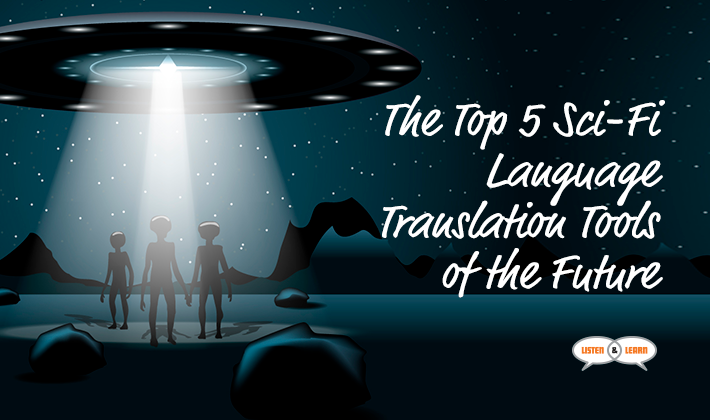The Top 5 Sci-Fi Language Translation Tools of the Future
Google Translate and its counterparts have revolutionised the way we translate language. That is a bold statement, we know. However, if you had the pleasure of translating a word or two by yourself, before these services came to life, which for Google Translate was in April 2006, trawling through website upon website for a good, reliable translation source was at best, time-consuming and at worst, frustrating as hell. Go back even further, if you can imagine such an archaic time as before a publicly available internet, then book stores, libraries and people more knowledgeable than yourself were where you would need to head.
The translation tools we have at hand currently, then, in short, seem perhaps to our parents as something out of Sci-Fi. But what about those devices that do appear in our favourite Sci Fi TV shows and films? Which of these imaginary tools are the most impressive? Let’s take a look at what is not-yet-available!
1. T.A.R.D.I.S.
GIF via Giphy
Okay, so we have revealed ourselves as Whovians, and proud ones at that, and so we should start off by saying that yes, we know the Tardis is a whole lot more than simply a translation device. For starters it is a Timelord’s transport of choice, but then it is also a home away from home, a time machine and even a real life person, depending on which episode you are watching. But in addition to this, via a telepathic field, the pilot and crew members of the Tardis are able to communicate in their language of choice for whichever time and location they may find themselves in, wherever they are in the galaxy. Even in Wales, where so much of Doctor Who is actually filmed.
2. C3PO
Yes, a controversial choice, because we know that C3PO is vastly more than a mere translation droid. But if you think about it, C3PO is a walking, talking, marvel of translation, able to communicate in something like six million different forms of languages, including the beeps and whistles of his partner in crime, R2-D2. True, he isn’t exactly portable and, okay, sometimes he is more than a little annoying. But hey, he can transport himself, has limbs enough to assist you with your shopping and also comes with an off switch. Better than many people, then.
3. Babelfish

GIF via Giphy
Come join us at the restaurant at the end of the universe! Pull up a chair and order yourself something to drink; we have a prime viewing spot for the big event. And while you do that, marvel at the wonder that is the Babelfish, the translation tool that is not for the squeamish. A small, yellow leech-like fish is inserted into the ear and forms a telepathic matrix with its host, so that the host can understand anything that is said by those around them. Now, if you aren’t familiar with A Hitchhiker's Guide To The Galaxy and what we are saying seems incomprehensible, then you can think of this book, turned into many a film and even a TV show, as the galactic version of Lonely Planet. Do give the book a read; you won’t regret it. But absolutely do not be inserting any fish into your ears.
Learning a new language? Check out our free placement test to see how your level measures up!
4. Farscape
We believe that the writers of Farscape are huge Douglas Adams fans, paying particular homage to his works via their own form of universal translator, the Translator Microbes. These microbes colonise in the user’s brain and translate anything that is said to them. As with most Sci Fi translation tools, the translator microbes do not give their users the ability to speak a wealth of languages, merely one to understand them. And another pitfall of the microbes is that they don’t do idioms; quelle desastre!
5. Star Trek
Finally, because Gene Roddenberry’s work must always be recognised and praised, the universal translator used throughout all of the Star Trek franchise has to be mentioned before we leave. The translators themselves have of course varied in appearance between the various shows and numerous films, and have shown the problems that come from relying solely on machines to do our work for us, however the basic premise is the same: the device must learn enough of the chosen language to be able to form a translation matrix in order to translate effectively. Genius.

GIF via Giphy
So there we have it! A small but choice selection of some of the best Sci-Fi translation devices. And whilst we ponder which of these are most likely to be an actual, viable tool in our future, next time we will look at attempts to create one true universal translator that would not look out of place amongst those we have just mentioned, what are the pitfalls of such a device, and is it truly possible to have one tool to rule them all? Until then!




